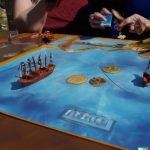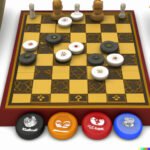Are you a fan of strategy board games? If so, there’s a good chance you’ve heard of Catan. Known for its competitive gameplay and intricate resource management, Catan has become a staple in the world of tabletop gaming. Its combination of luck and skill makes it an exciting challenge for players of all ages.
The history and legacy of Catan is fascinating, with roots dating back to the early 1990s when it was first published in Germany. Since then, it has gained a dedicated following and has been translated into numerous languages, solidifying its status as a classic in the world of tabletop gaming.
In this article, we will delve into the world of Catan, exploring its rules, strategy, tips for winning, and even its role in competitive play. Whether you’re new to the game or a seasoned veteran looking to hone your skills, there’s something for everyone in the world of Catan. So gather your resources and get ready to conquer new lands in this ultimate strategy board game.
The History and Legacy of Catan
The history of Catan dates back to 1995 when it was first released in Germany. Created by Klaus Teuber, the game quickly gained popularity for its unique blend of strategy, resource management, and negotiation. Over the years, Catan has become a global phenomenon, with millions of copies sold worldwide. Its legacy is marked by its influence on the modern board game industry and its ability to bring friends and families together for hours of competitive fun.
To this day, Catan remains one of the most iconic strategy board games, often credited with ushering in a new era of tabletop gaming. Its legacy is evident in the numerous awards it has received, including the prestigious Spiel des Jahres (Game of the Year) award in 1995. The game’s success has also spawned a plethora of expansions and spin-off editions, solidifying its status as a classic in the world of board gaming.
Since its inception, Catan has continued to evolve with the release of various expansions and alternate versions. The game’s enduring legacy is a testament to its staying power and ability to captivate players for over two decades. Whether it’s the base game or one of its many variations, Catan’s impact on the board game community is undeniable.
How to Play Catan
Catan, also known as Settlers of Catan, is a popular strategy board game that has captured the hearts of players around the world. The game, designed by Klaus Teuber, was first published in 1995 and has since become a beloved classic among board game enthusiasts. Catan is set on the fictional island of Catan, where players assume the roles of settlers attempting to build and develop their settlements while trading and acquiring resources.
To play Catan, you will need the game board, resource cards (brick, lumber, wool, grain, and ore), development cards, a robber token, settlements, roads, and cities. The game board is made up of hexagonal tiles that represent different terrains such as forests, hills, mountains, fields, and pastures. Each terrain produces a specific type of resource.
The goal of Catan is to be the first player to reach 10 victory points. Players earn victory points by building settlements and cities, buying development cards, holding the “Longest Road” card with at least 5 consecutive roads or having the “Largest Army” card through owning at least 3 knights-and by achieving special victory point conditions on some development cards.
| Component | Details |
|---|---|
| Game Board | Hexagonal tiles representing different terrains |
| Resource Cards | Brick, lumber, grain and ore |
| Development Cards | A variety of cards providing various benefits |
Players take turns rolling two dice to determine which terrain hexes produce resources. They then use these resources to build roads and new settlements or upgrade their settlements to cities. Through strategic trading with other players or via ports on the edges of the island for specific trades (e.g. trading four identical resources for a different random one), players can gather resources they lack.
The rules are simple enough for newcomers to learn quickly but offer enough depth for experienced players to continue exploring new strategies over time. Whether you are just starting out or have been playing for years enjoying this excellent strategy board game continues.
Understanding the Strategy Behind Catan
Importance of Early Settlement Placement
One of the key strategies in Catan is the early placement of settlements. Since resources are limited, players must strategically place their initial settlements to ensure access to a variety of resources. Wheat, ore, brick, wood, and sheep are essential for building roads, settlements, and cities, so it’s crucial to secure access to these resources early on.
Trading and Negotiation
Another important aspect of strategy in Catan is trading and negotiation with other players. Since no one player can have all the necessary resources at all times, trading becomes essential for progress. Players must strategize both in terms of what they are willing to give up and what they are seeking in order to make favorable trades.
Focus on Long-Term Growth
A successful strategy in Catan involves focusing on long-term growth rather than short-term gains. While it can be tempting to build as many settlements as possible initially, it’s important to keep an eye on city upgrades for later in the game. Upgrading settlements to cities is a vital part of gaining victory points for winning the game.
Understanding these strategic elements can greatly improve a player’s chances of success in Catan. By carefully considering placement decisions, engaging in effective trade negotiations, and planning for long-term growth, players can achieve victory in this highly competitive and engaging board game.
Tips and Tricks for Winning at Catan
Understanding Your Starting Position
When playing Catan, it is important to carefully consider your starting position on the game board. The initial placement of your settlements and roads will heavily influence your access to key resources such as brick, lumber, and grain. It is also crucial to secure a strong position for future expansion and potential road-building opportunities. By strategically placing your starting settlements, you can set yourself up for success in the later stages of the game.
Trading and Negotiation
One of the most important aspects of winning at Catan is mastering the art of trading and negotiation with other players. Since no single player can dominate all resources, it is essential to establish mutually beneficial trade agreements with opponents in order to acquire the specific resources needed for your strategy. Understanding the value of each resource and knowing when to make shrewd trades can be the difference between victory and defeat in Catan.
Adapting Your Strategy
In any game of Catan, it is crucial for players to remain adaptable and flexible in their strategies. As the game progresses, resource availability may change due to dice rolls or other player’s actions. Successful Catan players are able to recognize these shifts and adjust their plans accordingly.
Being able to pivot from one strategy to another based on changing circumstances can give you a significant advantage over less adaptable opponents. By being mindful of your starting position, mastering trade negotiations, and staying flexible with your strategy, you can increase your chances of winning at this iconic strategy board game – Catan.
Catan Expansions and Variants
Catan has expanded over the years to include various expansions and variants that add new elements to the game, keeping it fresh and exciting for experienced players. Here are some popular Catan expansions and variants that take the game to the next level:
- Seafarers of Catan: This expansion allows players to explore and settle the islands of Catan by building ships, discovering new lands, and establishing shipping lanes. It adds a maritime dimension to the game, creating new opportunities for trade and expansion.
- Cities & Knights: In this expansion, players go beyond just building settlements and cities by focusing on developing their metropolis. It introduces a new mechanic of city improvements and progress cards, adding a layer of complexity to the game’s strategy.
- Traders & Barbarians: This expansion includes several scenarios and variants that provide different ways to play Catan. From fishing grounds to barbarian attacks, each scenario offers a unique twist on the classic game.
In addition to official expansions, there are also fan-made variants that add even more diversity to Catan gameplay. These can range from small tweaks in rules or setups to entirely new themes for the game board.
As Catan continues to evolve with each new expansion or variant, it allows players to explore different strategies, adapt their gameplay style, and keep coming back for more challenges. Whether you’re a seasoned player looking for a fresh experience or a newcomer eager to delve deeper into the world of Catan, these expansions and variants truly take the game to the next level.
The Role of Resource Management in Catan
Resource management is a key aspect of the strategy board game Catan. In the game, players must gather and trade resources such as brick, wood, grain, ore, and wool in order to build roads, settlements, and cities. Understanding how to effectively manage these resources is crucial to success in Catan.
One important aspect of resource management in Catan is the concept of scarcity. Certain resources may be more abundant on the game board than others, making it necessary for players to adapt their strategies based on the availability of resources. For example, if brick and wood are scarce, players will need to find alternative ways to acquire these resources or shift their focus to building using different materials.
In addition to scarcity, trading also plays a significant role in resource management in Catan. Players are able to trade resources with one another or with the bank at specific exchange rates. Knowing when and how to make a trade can greatly impact a player’s ability to expand and grow within the game. Developing a keen understanding of resource scarcity and effective trading is essential for mastering the art of resource management in Catan.
| Aspect | Description |
|---|---|
| Scarcity | Certain resources may be more abundant than others on the game board. |
| Trading | Players can trade resources with one another or with the bank at specific exchange rates. |
The Social and Interactive Aspect of Playing Catan
Catan is not just about building roads and settlements; it’s also about the social and interactive aspect of playing the game. One of the key elements of Catan is negotiation. Players can trade resources, offer deals, or form alliances to get ahead in the game. This adds a layer of interaction that makes the game more dynamic and engaging.
The social aspect of Catan is what sets it apart from other strategy board games. It encourages players to communicate and interact with each other, whether it’s through friendly bartering or strategic negotiations. This makes the game not only about making the best moves, but also about understanding the motives and intentions of other players.
Beyond negotiation, playing Catan also allows for moments of friendly competition and camaraderie. Whether you’re blocking an opponent’s road, stealing their resources, or simply outmaneuvering them, there is a sense of satisfaction when you make a strategic move that impacts another player. This creates an interactive experience that keeps players engaged throughout the game.
In addition, playing Catan can also be a great way to bond with friends and family. The game requires collaboration and decision-making, which can lead to memorable experiences and inside jokes. The social dynamic of Catan makes it a perfect choice for game nights or gatherings, as it brings people together around a shared interest in strategy board games like Catan.
Catan Tournaments and Competitive Play
Competitive play of Catan has grown in popularity over the years, with many players looking to test their skills against others in a tournament setting. These tournaments provide a unique opportunity for Catan enthusiasts to showcase their strategic prowess and compete for various prizes and accolades. Participants are often required to employ advanced strategies, quick thinking, and adept decision-making in order to outmaneuver their opponents and emerge victorious.
To hone their skills for competitive play, aspiring Catan players can engage in various practice exercises and activities. This may involve studying different game scenarios, practicing resource management techniques, and developing adaptive strategies that can be employed under different circumstances. Furthermore, participating in local gaming groups or online forums dedicated to Catan can provide valuable insights and tips from experienced players who have excelled in competitive settings.
In addition to honing individual skills, participating in Catan tournaments also offers the opportunity for players to engage with the broader gaming community. These events allow participants to form connections with fellow enthusiasts, share their passion for the game, and learn from each other’s experiences.
The social aspect of competitive play not only adds to the overall enjoyment of the game but also fosters a sense of camaraderie among players who share a mutual love for strategy board games like Catan.
Conclusion
In conclusion, Catan has rightfully earned its reputation as the ultimate strategy board game. Its combination of resource management, social interaction, and intricate gameplay makes it a favorite among both casual gamers and serious competitors. The game’s rich history and legacy have also contributed to its enduring popularity, with numerous expansions and variants allowing players to continually experience new challenges and opportunities for strategic mastery.
One of the key factors that make Catan stand out is the depth of strategy involved in the game. From trading resources to strategically placing settlements and cities, every decision can have a profound impact on the outcome of the game. Understanding these strategic elements is essential for success in Catan, making it a game that rewards careful planning and foresight.
Furthermore, the social aspect of playing Catan adds another layer of enjoyment to the game. Negotiating trades with opponents, forming alliances, and vying for control of important resources create a dynamic and interactive gaming experience. This collaborative yet competitive nature sets Catan apart from other strategy board games, making it an engaging pastime for players of all skill levels.
Whether you’re a casual player looking for a fun way to spend an evening with friends or a competitive gamer seeking new challenges, Catan offers something for everyone. With its combination of strategic depth, social interaction, and ongoing expansion options, Catan truly deserves its status as the ultimate strategy board game. So gather your resources, hone your negotiation skills, and prepare for an epic journey into the world of Catan.

I love playing all kinds of games – from classics like Monopoly to modern favourites like Ticket to Ride.
I created this blog as a way to share my love of board games with others, and provide information on the latest releases and news in the industry.





